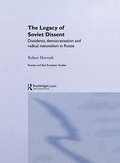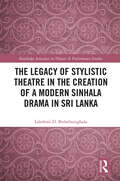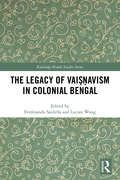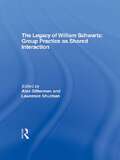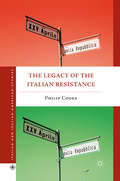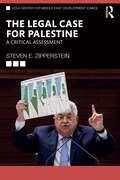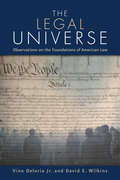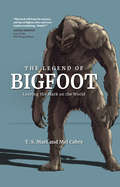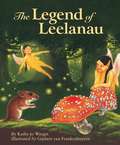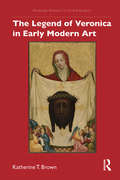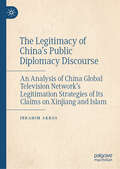- Table View
- List View
The Legacy of Soviet Dissent: Dissidents, Democratisation and Radical Nationalism in Russia (BASEES/Routledge Series on Russian and East European Studies #Vol. 17)
by Robert HorvathDuring the 1970s, dissidents like Sakharov and Solzhenitsyn dominated Western perceptions of the USSR, but were then quickly forgotten, as Gorbachev's reformers monopolised the spotlight. This book restores the dissidents to their rightful place in Russian history. Using a vast array of samizdat and published sources, it shows how ideas formulated in the dissident milieu clashed with the original programme of perestroika, and shaped the course of democratisation in post-Soviet Russia. Some of these ideas - such the dissidents' preoccupation with glasnost and legality, and their critique of revolutionary violence - became part of the agenda of Russia's democratic movement. But this book also demonstrates that dissidents played a crucial role in the rise of the new Russian radical nationalism. Both the friends and foes of Russian democracy have a dissident lineage.
The Legacy of Stylistic Theatre in the Creation of a Modern Sinhala Drama in Sri Lanka (ISSN)
by Lakshmi D. BulathsinghalaThis book explores the development of Sinhala stylistic drama from its earliest manifestations to the post-independence era.Bulathsinghala examines the impact of indigenous and imported folk theatrical forms on the work of the most significant postcolonial stylistic dramatists and on key plays that they produced. In the process, the book explores a number of myths and misunderstandings regarding Sri Lanka’s folk heritage and seeks to establish more reliable information on the principal indigenous Sri Lankan folk dramatic forms and their characteristics. At the same time, by drawing connections between folk drama and the post-independence stylistic theatrical movement, the author demonstrates the essential role of the former in Sinhala culture prior to the advent of Western and other influences and shows how both continue to inflect Sri Lankan drama today.This book will help to open the field of South Asian drama studies to an audience consisting not only of scholars and students but also of general readers who are interested in the fields of drama and theatre and Asian studies.
The Legacy of Vaiṣṇavism in Colonial Bengal (Routledge Hindu Studies Series)
by Ferdinando Sardella Lucian WongThis book offers a focused examination of the Bengali Vaiṣṇava tradition in its manifold forms in the pivotal context of British colonialism in South Asia. Bringing together scholars from across the disciplines of social and intellectual history, philology, theology, and anthropology to systematically investigate Vaiṣṇavism in colonial Bengal, this book highlights the significant roles—religious, social, and cultural—that a prominent Hindu devotional current played in the lives of wide and diverse sections of colonial Bengali society. Not only does the book thereby enrich our understanding of the history and development of Bengali Vaiṣṇavism, but it also sheds valuable new light on the texture and dynamics of colonial Hinduism beyond the discursive and social-historical parameters of an entrenched Hindu "Renaissance" paradigm. A landmark in the burgeoning field of Bengali Vaiṣṇava studies, this book will be of interest to scholars of modern Hinduism, religion, and colonial South Asian social and intellectual history.
The Legacy of Watergate and the Nixon Presidency: Nixon's Curse (The Evolving American Presidency)
by Michael A. GenoveseThis book examines the Nixon presidency, reviews the events surrounding Watergate and the President’ resignation, and unpacks the effects of Watergate on our politics and public attitudes about the political process. Genovese, a prolific scholar of the American presidency who has published three previous books on Nixon and Watergate, argues that the roots of modern political dysfunction and slash-and-burn politics can be traced to the impact of the Vietnam War, the Watergate Crisis, the policies and activities of the Nixon presidency, and the hyper-partisanship they spawned. Now, 50 years on from the scandal, it is time for a reappraisal of Nixon’s impact and a review of the impact he has had on our political system and political culture.
The Legacy of William Schwartz: Group Practice as Shared Interaction
by Alex Gitterman Lawrence ShulmanThis fine volume celebrates William Schwartz’s lasting contribution to teaching and scholarship and conveys the power of his ideas and their relevance to contemporary practice. This volume serves as a tribute to William Schwartz, whose writings have been a significant centerpiece in the literature of group work for many years. The distinguished contributors celebrate his lasting contribution to teaching and scholarship.
The Legacy of the Italian Resistance
by Philip CookeThis book adds to this growing body of scholarship on the Italian Resistance by analysing, for the first time, how the 'three wars' are represented over the broad spectrum of Resistance culture from 1945 to the present day. Furthermore, it makes this contribution to scholarship by bridging the gap between historical and cultural analysis. Whereas historians frequently use literary texts in their writings, they are often flawed by an insufficiently nuanced understanding of what a literary text is. Likewise, literary critics who have discussed writers such as Calvino and Vittorini, or films such Pais#65533; and La notte di San Lorenzo, only refer in passing to the historical context in which these works were produced. By fusing historical and cultural analysis, author Philip Cooke makes a unique contribution to our understanding of a key period of Italian history and culture.
The Legal Case for Palestine: A Critical Assessment (ISSN)
by Steven E. ZippersteinThis book critically analyzes the Palestinian legal arguments against Israeli occupation and in favor of Palestinian statehood.For the past two decades, Palestinians have chosen to pursue their claims against the Israeli occupation through litigation at the international courts. It is therefore appropriate, the author contends, to analyze the merits of the Palestinian legal claims separately from their political claims. To do so, the book comprises five parts: Part I addresses the role of international law in the conflict as well as Palestinian legal framing and lawfare. Part II recounts the relevant legal history, including the crucial legal implications of the Oslo Accords. Part III analyzes Palestinian legal claims regarding the West Bank and the Gaza Strip. Part IV assesses the Palestinian legal case for statehood. Part V analyzes Palestinian legal claims regarding Jerusalem. Ultimately, it is argued that the Palestinian legal case is weak even though the two-state solution continues to represent the most viable long-term political outcome to the conflict. Moreover, the author suggests that Palestinian leaders have repeatedly opted for conflict perpetuation through lawfare and violence, rather than conflict resolution through negotiation.Providing fresh insights into the claims and counterclaims of Palestinian legal arguments, the book will appeal broadly to anyone interested in the Israeli-Palestinian conflict and international law.
The Legal Protection of Women From Violence: Normative Gaps in International Law (Human Rights and International Law)
by Jackie Jones Rashida ManjooViolence against women remains one of the most pervasive human rights violations in the world today, and it permeates every society, at every level. Such violence is considered a systemic, widespread and pervasive human rights violation, experienced largely by women because they are women. Yet at the international level, there is a gap in the legal protection of women from violence. There is currently no binding international convention that explicitly prohibits such violence; or calls for its elimination; or, mandates the criminalisation of all forms of violence against women. This book critically analyses the treatment of violence against women in the United Nations system, and in three regional human rights systems. Each chapter explores the advantages and disadvantages coming from the legal instruments, the work of the monitoring systems, and the resulting findings and jurisprudence. The book proposes that the gap needs to be addressed through a new United Nations Convention on the Elimination of All Forms of Violence against Women, or alternatively an Optional Protocol to the Convention on the Elimination of all Forms of Discrimination against Women. A new Convention or Optional Protocol would be part of the transformative agenda that is needed to normatively address the promotion of a life free of violence for women, the responsibility of states to act with due diligence in the elimination of all forms of violence against all women, and the systemic challenges that are the causes and consequences of such violence.
The Legal Protection of the Intangible Cultural Heritage: A Comparative Perspective
by Pier Luigi PetrilloThis book describes the global legal framework for safeguarding the “Intangible Cultural Heritage” – as defined by the UNESCO Convention in 2003 – and analyses its use in selected countries in the Americas, Asia, Africa and Europe. Each of the contributions has been prepared by high profile experts and strategically addresses countries that are representative for their corresponding area. Our understanding of the term “Cultural Heritage” has changed considerably over the past few decades, and it is becoming increasingly clear that the concept also includes traditions and living expressions that we inherit from our ancestors and pass on to our descendants. UNESCO has recognised and responded to this change of perspective, creating through the 2003 Convention an international instrument for safeguarding the “Intangible Cultural Heritage”, a notion including oral traditions, performing arts, social practices, rituals, festive events, knowledge and practices concerning nature and the universe, as well as the knowledge and skills needed to produce traditional crafts. New values, practices and heritages were recognized – from the ancient African rituals to the Mexican Mariachi musical expression to the Brazilian Samba and the Mediterranean Diet – all of which convey strong social and cultural meaning for their community's identity. Intangible Cultural Heritage is a growing, relatively recent field of study and also an emblem of the dialogue between distant populations with different cultures, which is the reason why a comparative approach is the most appropriate basis for conducting an analysis of how the contracting states to the Convention live up to their commitments through national safeguarding measures and enhancement policies or through international cooperation projects.
The Legal Singularity: How Artificial Intelligence Can Make Law Radically Better
by Benjamin Alarie Abdi AididLaw today is incomplete, inaccessible, unclear, underdeveloped, and often perplexing to those whom it affects. In The Legal Singularity, Abdi Aidid and Benjamin Alarie argue that the proliferation of artificial intelligence–enabled technology – and specifically the advent of legal prediction – is on the verge of radically reconfiguring the law, our institutions, and our society for the better. Revealing the ways in which our legal institutions underperform and are expensive to administer, the book highlights the negative social consequences associated with our legal status quo. Given the infirmities of the current state of the law and our legal institutions, the silver lining is that there is ample room for improvement. With concerted action, technology can help us to ameliorate the problems of the law and improve our legal institutions. Inspired in part by the concept of the "technological singularity," The Legal Singularity presents a future state in which technology facilitates the functional "completeness" of law, where the law is at once extraordinarily more complex in its specification than it is today, and yet operationally, the law is vastly more knowable, fairer, and clearer for its subjects. Aidid and Alarie describe the changes that will culminate in the legal singularity and explore the implications for the law and its institutions.
The Legal Status Of The Arabs In Israel
by David KretzmerThis study examines how the Israeli legal system copes with two major issues. The first is the tension between the constitutional definition of Israel as both a Jewish state and a democracy committed to equal rights for all of its citizens. The second issue is the delicate position of a national minority in a state that since its establishment has been involved in a bitter conflict with the Palestinian nation to which that minority belongs.
The Legal Universe
by David E. Wilkins Vine Deloria Jr.According to the authors, "whenever American minorities have raised voices of protest, they have been admonished to work within the legal system that seek its abolition." This essential work examines the historical evolution of the legal rights of various groups in America and the relationship between these rights and the philosophical intent of the founders. Vine Deloria Jr. was named by Time magazine as one of the greatest religious thinkers of the twentieth century. He was a leading scholar who authored many acclaimed books, including God is Red: A Native View of Religion. Professor David E. Wilkins holds the McKnight Presidential Professorship in American Indian studies at the University of Minnesota.
The Legality of Boxing: A Punch Drunk Love? (Birkbeck Law Press)
by Jack AndersonThe first book of its kind dedicated to an assessment of the legality of boxing, The Legality of Boxing: A Punch Drunk Love? assesses the legal response to prize fighting and undertakes a current analysis of the status of boxing in both criminal legal theory and practice. In this book, Anderson exposes boxing’s 'exemption' from contemporary legal and social norms. Reviewing all aspects of boxing - historical, legal, moral, ethical, philosophical, medical, racial and regulatory - he concludes that the supposition that boxing has a (consensual) immunity from the ordinary law of violence, based primarily on its social utility as a recognised sport, is not as robust as is usually assumed. It: suggests that the sport is extremely vulnerable to prosecution and might in fact already be illegal under English criminal law outlines the physical and financial exploitation suffered by individual boxers both inside and outside the ring, suggesting that standard boxing contracts are coercive thus illegal and that boxers do not give adequate levels of informed consent to participate advocates a number of fundamental reforms, including possibly that the sport will have to consider banning blows to the head proposes the creation of a national boxing commission in the US and a similar entity in the United Kingdom, which together would attempt to restore the credibility of a sport long know as the red-light district of sports administration. An excellent book, it is a must read for all those studying sports law, popular culture and the law and jurisprudence.
The Legend of Bigfoot: Leaving His Mark on the World
by T. S. Mart Mel CabreAn accessible, entertaining guide that brings the infamous cryptid to life with legends, culture, and history from across the globe.Bigfoot. Sasquatch. Skunk Ape. He’s everywhere. The most well-known cryptid in American history, Bigfoot is as feared as he is loved. The subject of thousands of stories, this creature has been pegged as a monster terrorizing the woods, a supernatural entity stealthily living among us with an otherworldly agenda, or simply an animal trying to live a life of seclusion. With various theories and beliefs abounding, research and discussion have become a hobby for many, and even an occupation for some. In The Legend of Bigfoot: Leaving His Mark on the World, T. S. Mart and Mel Cabre reveal the myths, personal stories, and pop culture surrounding the legendary icon. Featuring more than 80 images recreating the Bigfoot’s appearance from firsthand accounts and folktales, The Legend of Bigfoot showcases the many faces of the creature. Included are the Boston Bahumagosh, which is said to weigh up to 400 pounds, stand up to 10 feet tall, and terrorize the Boston area; the Honey Island Swamp Monster?also known as the Louisiana Wookie?who roams the Louisiana swamps with yellow or red eyes; and the Wendigo, placed between 7 and 15 feet tall with long, yellow fangs and yellow-tinted skin. Half phantom, half beast, the Wendigo lives in the forest and dates back to the earliest Native American legends. “This book will keep the mystery and fun of Bigfoot alive and leave readers wondering, “Maybe?” —Laura Krantz, host of the Wild Thing podcast
The Legend of Leelanau
by Kathy-Jo WarginThe young maiden Leelinau is forbidden from going into the Spirit Wood. But Leelinau so enjoys her time spent there with the Pukwudjinees (the tiny fairies of the forest) that she risks playing with them time and time again. This legend explores the resistance many of us harbor of entering adulthood.
The Legend of Veronica in Early Modern Art (Routledge Research in Art and Religion)
by Katherine T. BrownIn The Legend of Veronica in Early Modern Art, Katherine T. Brown explores the lore of the apocryphal character of Veronica and the history of the “true image” relic as factors in the Franciscans’ placement of her character into the Via Crucis (Way of the Cross) as the Sixth Station, in both Jerusalem and Western Europe, around the turn of the fifteenth century. Katherine T. Brown examines how the Franciscans adopted and adapted the legend of Veronica to meet their own evangelical goals by intervening in the fabric of Jerusalem to incorporate her narrative − which is not found in the Gospels − into an urban path constructed for pilgrims, as well as in similar participatory installations in churchyards and naves across Western Europe. This book proposes plausible reasons for the subsequent proliferation of works of art depicting Veronica, both within and independent of the Stations of the Cross, from the early fifteenth through the mid-seventeenth centuries. This book will be of interest to scholars in art history, theology, and medieval and Renaissance studies.
The Legend of the White Buffalo Woman
by Paul GobleIn this most important of all Lakota legends--and a vivid invocation of the magic of the Plains Indian culture--Paul Goble brings to life the story of a mysterious and wonderful gift. Full color.
The Legendary Biographies of Tamerlane
by Ron SelaTimur (or Tamerlane) is famous as the fourteenth-century conqueror of much of Central Eurasia and the founder of the Timurid dynasty. His reputation lived on in his native lands and reappeared some three centuries after his death in the form of fictional biographies, authored anonymously in Persian and Turkic. These biographies have become part of popular culture. Despite a direct continuity in their production from the eighteenth century to the present, they remain virtually unknown to people outside the region. This remarkable and rigorous scholarly appraisal of the legendary biographies of Tamerlane is the first of its kind in any language. The book sheds light not only on the character of Tamerlane and how he was remembered and championed by many generations after his demise, but also on the era in which the biographies were written, and how they were conceived and received by the local populace during an age of crisis in their own history.
The Legends of the Jews
by Louis GinzbergTo this day Legends of the Jews remains a most remarkable and comprehensive compilation of stories connected to the Hebrew Bible. It is an indispensable reference on that body of literature known as Midrash, the imaginative retelling and elaboration on Bible stories in which mythological tales about demons and magic co-exist with moralistic stories about the piety of the patriarchs. Legends is the first book to which one turns to learn about the postbiblical understanding of a biblical episode, or to discover the source for biblical legends that cannot be traced directly to the Bible. It is also the first place to find the answers to such questions as: on what day was Abraham born; what was Moses' physical appearance, or what was the name of Potiphar's wife. Launched in 1901 by The Jewish Publication Society, the original project began as a single volume of 1,000 pages but grew much larger by 1938, when the seventh volume containing the indexes was finally published. Louis Ginzberg was 28 years old when Henrietta Szold, secretary of the Society, prepared the contract for what was conceived as a small, popular volume on Jewish legends. As the scion of two distinguished rabbinical families, Ginzberg studied in the great Lithuanian yeshivot of Telz and Slobodka. Later he received his secular education at Strassburg and Heidelberg universities. This combination of religious and secular learning enabled him to pursue with great passion the wide-ranging roots of Jewish legend. Ginzberg believed that Jewish legend was both earlier and greater than what was represented in the Talmud and midrashic collections--the primary Rabbinic sources. And so he scoured Jewish, Christian, Islamic, and Oriental sources to rediscover the fine threads of Jewish legend. The result was a masterpiece: a single, coherent collection of legends that follows the biblical narrative, accompanied by detailed notes that reveal a complex subtext of often intersecting and multi-layered levels of influence, borrowed notions, and interpretive commentaries.
The Legends of the Pyramids: Myths and Misconceptions about Ancient Egypt
by Jason ColavitoCould the Great Pyramid of Giza be a repository of ancient magical knowledge? Or perhaps evidence of a vanished pre–Ice Age civilization?Misinformation and myths have attached themselves to the Egyptian pyramids since ancient Greece and Rome. While many Americans believe that the pyramids were built by aliens, archaeologists understand that the Giza pyramids were built by the pharaohs of the Fourth Dynasty around 2450 BCE. So why is there such a disconnect between scholarly opinion and the popular view of Egypt? In The Legends of the Pyramids, Jason Colavito takes us back to Late Antique Egypt, where the replacement of polytheism with Christianity gave rise to local efforts to rewrite the stories of Egyptian history in the image of the Bible. When the Arab conquest absorbed Egypt into the Islamic community, these stories then passed into Islamic historiography and reentered the West. Colavito's The Legends of the Pyramids lays open pop culture's view of Egypt in movies, TV shows, popular books, and New Age beliefs, detailing how the hidden history of Egypt has grown alongside the official history of archaeology and Egyptology.
The Legitimacy of Bastards: The Place of Illegitimate Children in Later Medieval England
by Helen MatthewsAn in-depth look at the lives of illegitimate children and their parents in England in the later Middle Ages. For the nobility and gentry in later medieval England, land was a source of wealth and status. Their marriages were arranged with this in mind, and it is not surprising that so many of them had mistresses and illegitimate children. John de Warenne, earl of Surrey, married at the age of twenty to a ten-year-old granddaughter of Edward I, had at least eight bastards and a complicated love life. In theory, bastards were at a considerable disadvantage. Regarded as &‘filius nullius&’ or the son of no one, they were unable to inherit real property and barred from the priesthood. In practice, illegitimacy could be less of a stigma in late medieval England than it became between the sixteenth and late twentieth centuries. There were ways of making provision for illegitimate offspring and some bastards did extremely well—in the church, through marriage, as soldiers, and a few even succeeding to the family estates. The Legitimacy of Bastards is the first book to consider the individuals who had illegitimate children, the ways in which they provided for them and attitudes towards both the parents and the bastard children. It also highlights important differences between the views of illegitimacy taken by the Church and by the English law. &“Informative and well researched . . . A great resource for those who want to learn more about the late medieval period and illegitimate children.&” —Adventures of a Tudor Nerd
The Legitimacy of China’s Public Diplomacy Discourse: An Analysis of China Global Television Network’s Legitimation Strategies of Its Claims on Xinjiang and Islam
by Ibrahim AkbasThis book explores the public diplomacy discourse of Chinese state media on ethnic minorities in Xinjiang. China&’s minority policies towards Muslims in the Xinjiang Uyghur Autonomous Region have become an issue of contention in global politics that could further damage China&’s global reputation. Many states and prominent individuals position themselves by reacting either in support of or in opposition to the treatment of the Muslim minority in Xinjiang. Examining 54 English language Videos about Xinjiang and Islam produced by and broadcast on the China Global Television Network&’s (CGTN) YouTube Channel, this book analyzes how the Chinese state makes truth-claims about Xinjiang and Islam to discursively legitimise its official positions. The book argues that CGTN narrates the monolithic state perspective rather than seeking to establish a common ground of shared norms and values to acquire legitimacy. One key finding arising from CGTN&’s narratives is the notion of harmony as a prerequisite for economic development. By examining China's discursive legitimising narratives around Xinjiang, the thesis contributes to the research literature on China&’s public diplomacy and provides a novel framework for understanding the role of (de)legitimation strategies in public diplomacy practice.
The Legitimacy of Healthcare and Public Health: Anthropological Perspectives (Palgrave Studies in Urban Anthropology)
by Italo Pardo Giuliana B. PratoThe complex, highly problematic, often thorny dynamics of trust and authority are central to the anthropological study of legitimacy. In this book, this sine qua non runs across the in-depth examination of the ways in which healthcare and public health are managed by the authorities and experienced by the people on the ground in urban Europe, the USA, India, Africa, Latin America and the Far and Middle East. This book brings comparatively together anthropological studies on healthcare and public health rigorously based on in-depth empirical knowledge. Inspired by the current debate on legitimacy, legitimation and de-legitimation, the contributions do not refrain from taking into account the impact of the Covid-19 pandemic on the health systems under study, but carefully avoid letting this issue monopolise the discussion. This book raises key challenges to our understanding of healthcare practices and the governance of public health. With a keen eye on urban life, its inequalities and the ever-expanding gap between rulers and the ruled, the findings address important questions on the complex ways in which authorities gain, keep, or lose the public’s trust.
The Legitimacy of Modern Democracy: A Study on the Political Thought of Max Weber, Carl Schmitt and Hans Kelsen (Routledge Innovations in Political Theory)
by Pedro T. MagalhãesBy re-examining the political thought of Max Weber, Carl Schmitt and Hans Kelsen, this book offers a reflection on the nature of modern democracy and the question of its legitimacy. Pedro T. Magalhães shows that present-day elitist, populist and pluralist accounts of democracy owe, in diverse and often complicated ways, an intellectual debt to the interwar era, German-speaking, scholarly and political controversies on the problem(s) of modern democracy. A discussion of Weber’s ambivalent diagnosis of modernity and his elitist views on democracy, as they were elaborated especially in the 1910s, sets the groundwork for the study. Against that backdrop, Schmitt’s interwar political thought is interpreted as a form of neo-authoritarian populism, whereas Kelsen evinces robust, though not entirely unproblematic, pluralist consequences. In the conclusion, the author draws on Claude Lefort’s concept of indeterminacy to sketch a potentially more fruitful way than can be gleaned from the interwar German discussions of conceiving the nexus between the elitist, populist and pluralist faces of modern democracy. The Legitimacy of Modern Democracy will be of interest to political theorists, political philosophers, intellectual historians, theoretically oriented political scientists, and legal scholars working in the subfields of constitutional law and legal theory.
